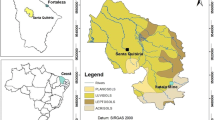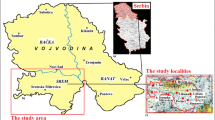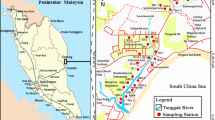Abstract
Assessment of spatial patterns of potentially toxic metals is one of the most urgent tasks in soil chemistry. In this study, descriptive statistics and three methods of multivariate statistical analysis, such as the hierarchical cluster analysis (HCA), correlation analysis, and conditional inference tree (CIT), were used to identify patterns and potential sources of heavy metals (Co, Ni, Cu, Cr, Pb, MnO, and Zn). The investigation was carried out on 81 sample points, using 20 testing parameters. A strong positive correlation found among Ni, Cu, Zn, and HCA results has confirmed the common origin of the elements from waste discharge. Hierarchical CA divided the 81 test sites into 5 classes based on the soil quality and HMs contamination similarity. Regression trees for Cr, Pb, Zn, and Cu were verified by the splitting factor including HMs content and soil chemistry factors. The CIT has revealed that the elements (Cr, Pb, Zn, and Cu) concentration values are split at the first level by some other metal, indicating common anthropogenic impact resulting from industrial waste discharges. The factors at the next hierarchical level of splitting, in addition to the HMs, include compounds belonging to soil chemistry variables (SiO2, Al2O3, and K2O). The CIT nonlinear regression model is in good agreement with the data: R2 values for log-transformed concentrations of Cr, Pb, Zn, and Cu are equal to 0.775; 0.774; 0.775; 0.804, respectively.








Similar content being viewed by others
Data availability
The raw/processed data required to reproduce these findings cannot be shared at this time as the data also form part of an ongoing study.
References
Alekseenko, V. A., & Alekseenko, L. P. (2003). Geochemical barriers. Moscow: Logos. (in Russian).
Ali, M. H., Mustafa, A.-R.A., & El-Sheikh, A. A. (2016). Geochemistry and spatial distribution of selected heavy metals in surface soil of Sohag, Egypt: A multivariate statistical and GIS approach. Environmental Earth Sciences, 75, 1257. https://doi.org/10.1007/s12665-016-6047-x.
Attia, O. E. A., & Ghrefat, H. (2013). Assessing heavy metal pollution in the recent bottom sediments of Mabahiss Bay, North Hurghada, Red Sea Egypt. Environmental Monitoring and Assessment, 185, 9925–9934. https://doi.org/10.1007/s10661-013-3302-4.
Barbieri, M., Sappa, G., Vitale, S., Parisse, B., & Battistel, M. (2014). Soil control of trace metals concentrations in landfills: A case study of the largest landfill in Europe, Malagrotta Rome. Journal of Geochemical Exploration., 143, 146–154. https://doi.org/10.1016/j.gexplo.2014.04.001.
Basta, N. T., Ryan, J. A., & Chaney, L. (2005). Trace element chemistry in residual-treated soil: Key concepts and metal bioavailability. Journal of Environmental Quality, 34, 49–63.
Bauer, T. V., Linnik, V. G., Minkina, T. M., Mandzhieva, S. S., & Nevidomskaya, D. G. (2018). Ecological-Geochemical studies of technogenic soils in the flood plain landscapes of the Seversky Donets Lower Don Basin. Geochemistry International, 56(10), 992–1002. https://doi.org/10.1134/S001670291810004X.
Bradl, H. B. (2004). Adsorption of heavy metal ions on soils and soils constituents. Journal of Colloid and Interface Science, 277, 1–18. https://doi.org/10.1016/j.jcis.2004.04.005.
Breiman, L., Friedman, J. H., Olshen, R. A., & Stone, C. J. (1984). Classification and regression trees. Belmont, California: Wadsworth Inc.
CCME (Canadian Council of Ministers of the Environment). (1999). Canadian soil quality guidelines for the protection of environmental and human health: Chromium (total 1997) (VI 1999). In Canadian environmental quality guidelines. Winnipeg: Canadian Council of Ministers of the Environment. http://ceqg-rcqe.ccme.ca/download/en/262/. Accessed 5 December 2019.
De’ath, G., & Fabricius, K.E. . (2000). Classification and regression trees: A powerful yet simple technique for ecological data analysis. Ecology, 81, 3178–3192. https://doi.org/10.2307/177409.
Dolezalova Weissmannova, H., Mihocova, S., Chovanec, P., & Pavlovsky, J. (2019). Potential ecological Risk and human health risk assessment of heavy metal pollution in industrial affected soils by coal mining and metallurgy in Ostrava, Czech Republic. International Journal of Environmental Research and Public Health, 16(22), 1–19. https://doi.org/10.3390/ijerph16224495.
Facchinelli, A., Sacchi, E., & Mallen, L. (2001). Multivariate statistical and GIS-based approach to identify heavy metal sources in soils. Environmental Pollution, 114, 313–324. https://doi.org/10.1016/S0269-7491(00)00243-8.
Ghosh, P., Samanta, A. N., & Ray, S. (2011). Reduction of COD and removal of Zn2+ from rayon industry wastewater by combined electro-Fenton treatment and chemical precipitation. Desalination, 266(1–3), 213–217. https://doi.org/10.1016/j.desal.2010.08.029.
GN 2.1.7.2041–06. (2006) Maximum allowable concentration (MAC) of chemicals in the soil. Moscow: Federal center for hygiene and epidemiology of rospotrebnadzor. (in Russian).
GN 2.1.7.2511–09. (2009) Approxible Permissible Concentrations (APC) of Chemical Matters in Soil. Moscow: Federal center for hygiene and epidemiology of rospotrebnadzor. (in Russian).
Goovaerts, P. (1997). Geostatistics for natural resources evaluation. New York: Oxford University Press.
GOST (State Standard) 17.4.4.02–84 (2008). Nature Protection. Methods of Sampling and Sample Preparation for Chemical, Bacteriological, and Helmintologic Analysis. Standardinform, Moscow. (in Russian).
Grigoriev, N. A. (2009). Chemical element distribution in the upper continental crust. Ekaterinburg: UB RAS. (in Russian).
Harter, R. D. (1983). Effect of soil pH on adsorption of lead, copper, zinc, and nickel. Soil Science Society of America Journal, 47, 47–51. https://doi.org/10.2136/sssaj1983.03615995004700010009x.
Hastie, T., Tibshirani, R., & Friedman, J. (2009). The elements of statistical learning data mining, inference, and prediction (2nd ed.). Springer: New York.
Hothorn, T., Hornik, K, Strobl, Carolin & Zeileis A. (2013). Party: A laboratory for recursive partytioning, http://cran.r-project.org/web/packages/party/party.pdf
Hothorn, T., Hornik, K., & Zeileis, A. (2006). Unbiased recursive partitioning: A conditional inference framework. Journal of Computational and Graphical Statistics, 15(3), 651–674. https://doi.org/10.1198/106186006X133933.
Hou, D., O’Connor, D., Nathanail, P., Tian, L., & Ma, Y. (2017). Integrated GIS and multivariate statistical analysis for regional scale assessment of heavy metal soil contamination: A critical review. Environmental Pollution, 231, 1188–1200. https://doi.org/10.1016/j.envpol.2017.07.021.
Hu, Y. A., & Cheng, H. F. (2013). Application of stochastic models in identification and apportionment of heavy metal pollution sources in the surface soils of a large-scale region. Environmental Science and Technology, 47, 3752–3760. https://doi.org/10.1021/es304310k.
ISO 10390, 2005. Soil Quality – Determination of pH.
ISO 13317–2, 2001. Determination of Particle Size Distribution by Gravitational Liquid Sedimentation Methods – Part 2: Fixed Pipette Method.
ISO 14235, 1998. Soil Quality – Determination of Organic Carbon by Sulfochromic Oxidation.
ISO NF EN 23470, 2011. Soil Quality – Determination of Effective Cation Exchange Capacity (CEC) and Exchangeable Cations.
IUSS Working Group WRB, 2015. World reference base for soil resources 2014, update 2015. International soil classification system for naming soils and creating legends for soil maps. World Soil Resources Reports No. 106. FAO, Rome.
Jin, Y., O’Connor, D., Ok, Y. S., Tsang, D. C. W., Liu, A., & Hou, D. (2019). Assessment of sources of heavy metals in soil and dust at children’s playgrounds in Beijing using GIS and multivariate statistical analysis. Environment International, 124, 320–328. https://doi.org/10.1016/j.envint.2019.01.024.
Konstantinova, E., Burachevskaya, M., Mandzhieva, S., Bauer, T., Minkina, T., Chaplygin, V., et al. (2020). Geochemical transformation of soil cover and vegetation of a drained floodplain lake affected by long-term dumping of effluents from rayon industry plant (lower Don Basin, Southern Russia). Environmental Geochemistry and Health. https://doi.org/10.1007/s10653-020-00683-3.
Kubosova, K., Komprda, J., Jarkovsky, J., Sanka, M., Hajek, O., Dusek, L., et al. (2009). Spatially resolved Distribution models of POP concentrations in soil: A stochastic approach using regression trees. Environmental Science and Technology, 43, 9230–9236. https://doi.org/10.1021/es902076y.
Lasat, M. (2002). Phytoextraction of toxic metals: A review of biological mechanisms. Journal of Environmental Quality, 31, 109–120.
Lee, S. Z., Chang, L., Yang, H. H., Chen, C. M., & Liu, M. C. (1998). Adsorption characteristics of lead onto soils. Journal of Hazardous Materials, 63, 37–49. https://doi.org/10.1016/S0304-3894(98)00203-9.
Li, J., He, M., Han, W., & Gu, Y. (2009). Analysis and assessment on heavy metal sources in the coastal soils developed from alluvial deposits using multivariate statistical methods. Journal of Hazardous Materials, 164, 976–981. https://doi.org/10.1016/j.jhazmat.2008.08.112.
Liu, L., Liu, Q., Ma, J., Wu, H., Qu, Y., Gong, Y., et al. (2020). Heavy metal(loid)s in the topsoil of urban parks in Beijing. China: Concentrations, potential sources, and risk assessment, Environmental Pollution. https://doi.org/10.1016/j.envpol.2020.114083.
Liu, X., Wu, J., & Xu, J. (2006). Characterizing the risk assessment of heavy metals and sampling uncertainty analysis in paddy field by geostatistics and GIS. Environmental Pollution, 141, 257–264. https://doi.org/10.1016/j.envpol.2005.08.048.
Lund, L. J., Betty, E. E., Page, A. L., & Elliot, R. A. (1981). Occurrence of high Cd levels in soil and its accumulation by vegetation. Journal of Environmental Quality, 10, 551–556. https://doi.org/10.2134/jeq1981.00472425001000040027x.
Maas, S., Scheifler, R., Benslama, M., Crini, N., Lucot, E., Brahmia, Z., et al. (2010). Spatial distribution of heavy metal concentrations in urban suburban and agricultural soils in a Mediterranean city of Algeria. Environmental Pollution, 158, 2294–2301. https://doi.org/10.1016/j.envpol.2010.02.001.
McLaren, R. G., Williams, J. G., & Swift, R. S. (1983). The adsorption of copper by soil samples from Scotland at low equilibrium solution concentrations. Geoderma, 31, 97–106. https://doi.org/10.1016/0016-7061(83)90001-0.
Minkina, T., Nevidomskaya, D., Bauer, T., Shuvaeva, V., Soldatov, A., Mandzhieva, S., et al. (2018). Determining the speciation of Zn in soils around the sediment ponds of chemical plants by XRD and XAFS spectroscopy and sequential extraction. Science of the Total Environment., 634, 1165–1173. https://doi.org/10.1016/j.scitotenv.2018.04.118.
Minkina, T. M., Nevidomskaya, D. G., Fedorov, Yu. A., Mandzhieva, S. S., Chaplygin, V. A., Bauer, T. V., & Burachevskaya, M. V. (2017). Heavy metals in the soil–plant system of the Don River estuarine region and the Taganrog Bay coast. Journal Soils Sediments, 17, 1474–1491. https://doi.org/10.1007/s11368-016-1381-x.
Minkina, T. M., Soldatov, A. V., Nevidomskaya, D. G., Motuzova, G. V., Podkovyrina, Yu. S., & Mandzhieva, S. S. (2016). New approaches to studying heavy metals in soils by X-ray absorption spectroscopy (XANES) and extractive fractionation. Geochemistry International, 54(2), 197–204. https://doi.org/10.1134/S001670291512006X.
Peijnenburg, W. J., Baerselman, R., de Groot, A. C., Jager, T., Posthuma, L., & Van Veen, R. P. (1999). Relating environmental availability to bioavailability: soil-type-dependent metal accumulation in the oligochaete Eisenia andrei. Ecotoxicology and Environmental Safety, 44, 294–310. https://doi.org/10.1006/eesa.1999.1838.
Privalenko, V. V., & Cherkashina, I. F. (2012). Rekul’tivacija shlamonakopitelej himicheskih zavodov v Rostovskoj oblasti [Recultivation of Rostov region chemical industry waste fields]. In T. S. Chibrik (Ed.), Biologicheskaja rekul’tivacija i monitoring narushennyh zemel’ [Biological recultivation and monitoring of disturbed lands] (pp. 205–209). Yekaterinburg: Publishing House of the Ural University.
Privalenko, V. V., Mazurenko, V. T., Panaskov, V. I., Moshkin, V. M., Mukhin, N. V., & Senin, B. K. (2000). Ecological problems of the city of Kamensk-Shakhtinsky. Rostov-on-Don: Tsvetnaya pechat. (in Russian).
Reimann, C., Filzmoser, P., Garrett, R. G., & Dutter, R. (2008). Statistical data analysis explained: Applied environmental statistics with R. Hoboken: Wiley.
Ryo, M., & Rillig, M. C. (2017). Statistically reinforced machine learning for nonlinear patterns and variable interactions. Ecosphere. https://doi.org/10.1002/ecs2.1976.
Saby, N. P. A., Thioulouse, J., Jolivet, C. C., Ratie, C., Boulonne, L., Bispo, A., & Arrouays, D. (2009). Multivariate analysis of the spatial patterns of 8 trace elements using the French soil monitoring network data. Science of The Total Environment, 407, 5644–5652. https://doi.org/10.1016/j.scitotenv.2009.07.002.
Salah, E. A., Turki, A. M., & Mahal, S. N. (2015). Chemometric evaluation of the heavy metals in urban soil of Fallujah city, Iraq. Journal of Environmental Protection, 6, 1279–1292. https://doi.org/10.4236/jep.2015.611112.
Savelyev, A. A., Mukharamova, S. S., Pilyugin, A. G., & Chizhikova, N. A. (2012). Geostatistical data analysis in ecology and nature management (using the R package). Kazan: Kazan University. (in Russian).
Shan, Y., Tysklind, M., Hao, F., Ouyang, W., Chen, S., & Lin, C. (2013). Identification of sources of heavy metals in agricultural soils using multivariate analysis and GIS. Journal of Soils and Sediments, 13, 720–729. https://doi.org/10.1007/s11368-012-0637-3.
Strasser, H., & Weber, C. (1999). On the asymptotic theory of permutation statistics. Mathematical Methods of Statistics, 8, 220–250.
Venables, W. N., & Smith, D. M. (2009). An introduction to R: A programming environment for data analysis and graphics. Bristol, UK: Network Theory Ltd.
Zeng, F., Ali, S., Zhang, H., Ouyang, Y., Qiu, B., Wu, F., & Zhang, G. (2011). The influence of pH and organic matter content in paddy soil on heavy metal availability and their uptake by rice plants. Environmental Pollution, 159, 84–91. https://doi.org/10.1016/j.envpol.2010.09.019.
Zhang, C., & Yang, Y. (2020). Modeling the spatial variations in anthropogenic factors of soil heavy metal accumulation by geographically weighted logistic regression. Science of The Total Environment, 717, 137096. https://doi.org/10.1016/j.scitotenv.2020.137096.
Zhang, X. Y., Lin, F. F., Jiang, Y. G., Wang, K., & Wong, M. T. F. (2008). Assessing soil Cu content and anthropogenic influences using decision tree analysis. Environmental Pollution, 156, 1260–1267. https://doi.org/10.1016/j.envpol.2008.03.009.
Zhong, B. Q., Liang, T., Wang, L. Q., & Li, K. X. (2014). Applications of stochastic models and geostatistical analyses to study sources and spatial patterns of soil heavy metals in a metalliferous industrial district of China. Science of The Total Environment, 490, 422–434. https://doi.org/10.1016/j.scitotenv.2014.04.127.
Zhou, J., Ma, D., Pan, J., Nie, W., & Wu, K. (2008). Application of multivariate statistical approach to identify heavy metals sources in sediments and waters: A case study in Yangzhong, China. Environmental Geology, 54, 373–380. https://doi.org/10.1007/s00254-007-0824-5.
Acknowledgements
This research was financially supported by the Ministry of Science and Higher Education of the Russian Federation (No. 0852-2020-0029), the Russian Foundation for Basic Research (Grant No.19-34-60041) and budget theme 0137-2019-0008 (GEOKHI RAS).
Funding
This research was sponsored by the Ministry of Science and Higher Education of the Russian Federation (No. 0852-2020-0029), the Russian Foundation for Basic Research (Grant No.19-34-60041) and budget theme 0137-2019-0008 (GEOKHI RAS).
Author information
Authors and Affiliations
Contributions
Vitaly Linnik was involved in methodology, original draft preparation, writing—review & editing. Anatoly Saveliev helped in software and formal analysis, writing—review & editing. Tatiana Bauer contributed to formal analysis, investigation, writing—review & editing. Tatiana Minkina was involved in conceptualization, supervision, writing—review & editing. Saglara Mandzhieva helped in investigation, data curation, formal analysis, supervision.
Corresponding author
Ethics declarations
Conflicts of interest
The authors declare that they have no known competing financial interests or personal relationships that could have appeared to influence the work reported in this paper.
Consent to participate
Not applicable.
Consent for publication
Not applicable.
Ethics approval
Not applicable since the manuscript has not been involved the use of any animal or human data or tissue.
Additional information
Publisher's Note
Springer Nature remains neutral with regard to jurisdictional claims in published maps and institutional affiliations.
Rights and permissions
About this article
Cite this article
Linnik, V.G., Saveliev, A.A., Bauer, T.V. et al. Analysis and assessment of heavy metal contamination in the vicinity of Lake Atamanskoe (Rostov region, Russia) using multivariate statistical methods. Environ Geochem Health 44, 511–526 (2022). https://doi.org/10.1007/s10653-021-00853-x
Received:
Accepted:
Published:
Issue Date:
DOI: https://doi.org/10.1007/s10653-021-00853-x




